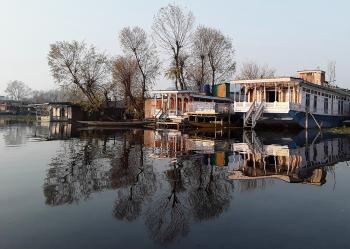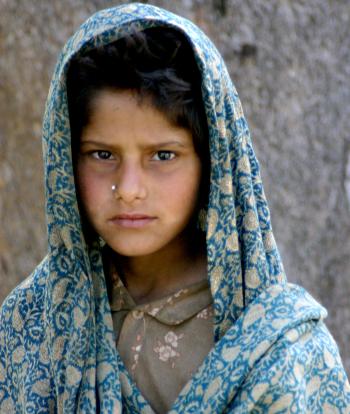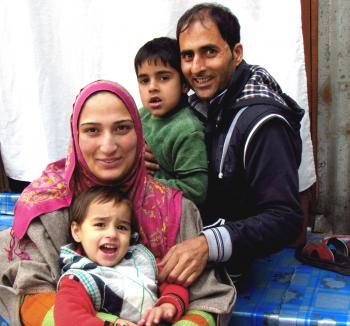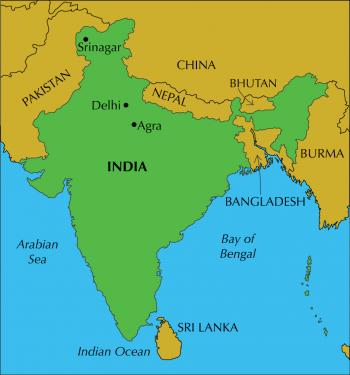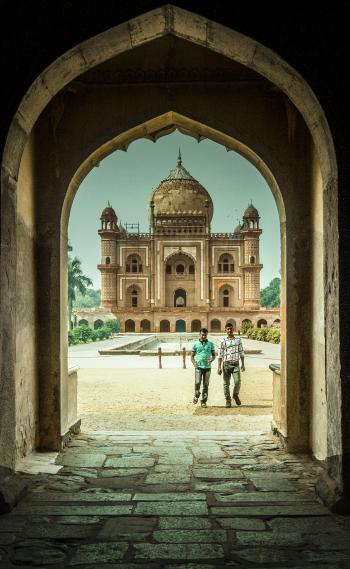A homestay visit in Srinagar, India
This article appears on page 6 of the January 2022 issue.
Some opportunities present themselves once in a lifetime. When the invitation arrived for me to visit my dear friend Hilal, whom I met years ago in Delhi, and his family in Srinagar, India, in November 2019, without blinking an eye, I jumped at the opportunity.
Often referred to as “paradise on Earth,” Srinagar is the largest city of the Indian state of Jammu and Kashmir, nestled below the snowcapped Himalayas in northwest India. A main attraction there is the luxurious houseboats that can be found along the shores of the lakes Dal and Nageen.
Starting in Delhi
I arrived in Delhi, where I would begin my journey, in the early hours of the morning. I was met at the airport by a representative of Hotel Grand Godwin (8502 Arakashan Road, Paharganj; godwinhotels.com), which offered free pickup.
My hotel room was very clean and spacious, with attached bath, air- conditioning and internet access, and the hotel had a small, air-conditioned rooftop restaurant that offered a variety of both Indian and Continental food. Within a one-minute walk from the hotel were ATM facilities, and there were several shops nearby selling snacks, fruit and mineral water.
After a much-needed rest, I arranged for a car with driver at the hotel’s travel desk for a day’s sightseeing in Delhi (about $45). Delhi, the capital of India, is a huge city, and there are countless places of interest to visit — colorful markets, noisy bazaars and magnificent temples with elaborate designs of all shapes and colors.
My first stop was the Jama Masjid (Grand Mosque), one of the largest mosques in India. At Friday prayer, it can accommodate 25,000 worshipers.
The magnificently designed mosque was surrounded by a large courtyard with several arches. There were three large domes and two minarets, and adventurous travelers could climb the endless steps to the top of the minarets for a picturesque panorama of Delhi.
Other sites visited included the tomb of Humayun, the second of the Mughal emperors, surrounded by a magnificent landscaped garden, and Raj Ghat, the cremation site of Mahatma Gandhi, where garlands of colorful flowers adorned the memorial and crowds of people were paying respect to this iconic, peaceful man.
As my driver made his way back to my hotel, I couldn’t help but notice my surroundings — the crowds, the cows lying in the middle of the street, the noisy tuk-tuks (auto rickshaws) and young children carrying smaller children holding out a hand to beg for small change.
It was a fantastic, eye-opening experience and a huge cultural shock.
An iconic site
A symbol of India, the Taj Mahal in Agra is perhaps the most romantic structure ever built. I made arrangements, again through the travel desk at my hotel, to purchase a train ticket for a day trip to Agra.
I chose the Bhopal Express, train No. 2002, which departed at 6:15 a.m. from the train station located a 5-minute walk from the hotel. An air-conditioned seat in first class from Delhi to Agra and back cost 800 rupees (about $11).
Being interested in photography, I chose not to book a group tour so I could be free to wander at my own pace.
Arriving in Agra at 8:20, I took a tuk-tuk to the Taj. In order to protect it from pollution, motor vehicles can only go within a certain distance of the site. Visitors can either take an electric car the rest of the way (for a small fee) or walk. I chose to walk the short distance.
The entry fee is about 1,000 rupees, and no food or drink is permitted inside the complex.
My first view of the Taj Mahal, through an intricately carved archway, took my breath away, the morning light illuminating its façade. It shimmered like a jeweled pearl!
I stood for a few moments, staring at the ivory mausoleum beautifully reflected in the pool of water in front of it, before I slowly approached it, removing my shoes and climbing the stairway.
I spent a leisurely morning admiring this architectural masterpiece before making my way to the train station, arriving back in Delhi at 10:30 p.m.
On to Srinagar
After an early breakfast the next morning, I left for the airport for a less-than-2-hour flight from Delhi to Srinagar on Air India (about $72). Upon arrival, I was informed that all foreigners need to register with the authorities, as a record is kept of where and with whom visitors are staying.
Outside of the airport, I was greeted by my friend Hilal. He gladly welcomed me to Kashmir, and soon we were on our way to his home.
As we approached Hilal’s house, we were greeted by his two children, both barefooted. The house, a huge 3-story structure, was located in the center of a large landscaped garden surrounded by a high metal fence. Once inside the house, I was introduced to his lovely wife, Sheema, and his mother and father.
In no time at all, Hilal’s mother served us Kashmiri tea. It had a wonderful but unfamiliar flavor — very calming and aromatic.
The morning seemed to arrive earlier than I expected. Very comfortable in my bed, I stared at the ceiling and wondered what was in store for me in this tiny paradise way below the mighty Himalayas.
As an introduction to Srinagar, Hilal had made arrangements for us to go on a boat ride on Dal Lake. The flat-bottomed boats, called shikaras, were extremely colorful, each with a canopy on top. To ward off the morning chill, a heavy blanket was provided for us.
The banks of the lake were lined with hundreds of houseboats, all beautifully embellished. Flowerpots with flowers were everywhere.
As our boat glided gently on the water, I saw the hands of occupants of the houseboats waving “Hello” and women doing laundry in the lake. Everything seemed very peaceful.
Soon we arrived at Hilal’s uncle’s houseboat, and we were invited to tea — apparently a common practice when receiving visitors. Entering through an opened glass door, I was amazed at the magnificent interior of the houseboat. There were several sofas lining the walls, and a huge crystal chandelier gently hung down over a round table. The floors were completely covered with colorful Kashmiri silk carpets.
While I enjoyed my tea and cookies, my eyes were kept busy admiring my unbelievable surroundings.
The cost of a stay in one of those houseboats is determined by its “category,” ranging from basic to extreme luxury. I don’t think I would have any problem pampering my tired bones for a few days in a luxurious houseboat!
Continuing along the canals, Hilal docked our shikara in front of one of the many waterfront gardens so that we could enjoy a leisurely walk. Flowers of various colors were laid out in a delicate pattern, creating a magnificent view. A canal with water fountains shooting water several feet in the air added to the soothing atmosphere.
After a much-appreciated visit to a Mughal garden, Hilal and I were back on the water. Soon we reached the beautiful Hazratbal Shrine, constructed of white marble, with a dome and minaret. Located on the western shore of Dal Lake, it commanded a grand view of the lake and the mountains beyond.
Houseboat communities have existed for centuries on these lakes. Doctors, tailors, bakers … all can be seen in the small shops situated near vegetable gardens and acres of lotus gardens. I kept asking myself if I was in a dream.
After a few minutes, we arrived at a floating market. From small boats, vendors were selling a variety of vegetables and fruit, neatly arranged for prospective buyers. Some of the vegetables and fruits were familiar to me, while others were completely unknown.
Boats filled with mouthwatering apples and strawberries attracted my attention, and we stopped to make a small purchase.
The people, living far from the demands and noises of the outside world, possessed a kindness that was shared with all visitors to their world. There seemed to be no rush to go anywhere.
Once you have visited Srinagar, I’m sure you will agree that what began as a dream will live on as an unforgettable memory.

